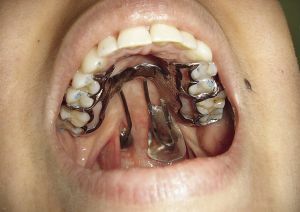 Obturator is a special device that eliminates congenital or acquired palatine defects in the oral cavity.
Obturator is a special device that eliminates congenital or acquired palatine defects in the oral cavity.
This prosthesis is made of metal, rubber or plastic, with the help of which it becomes possible to normalize the functions of breathing, speech, food intake.
Obturator for the soft palate is characterized by a difficult fixation due to its location on the mobile tissues. The device for the hard palate is the base plate to which the defect is covered. Clamps are used to fix it.
content
- Historical background
- Indications
- methods
- fastening Most known designs
- By Syuersenu
- By Shildskomu
- floating obturator Kez
- Modification Kez apparatus
- Apparatus Il'inoy-Markosyan
- By Pomerantseva-urban
- product B. Kurland
- palatine plate
Historicalexcursion
For the first time orthopedic devices with the help of which palatal defects are closed, the well-known military surgeon of France A.Pare used it in her practice. As far back as the 16th century, he proposed a device that looked like a gold cufflink. It was assumed that, on the one hand, the structure would be fixed in the nasal cavity, and on the other in the oral cavity. Both parts were connected with special forceps.
Subsequently, the Pare apparatus was repeatedly subjected to various modifications. In the 17th century, Foshar suggested changing the look and fixing of the apparatus. Since then, the plate has wings, and for its production used ivory.
At the end of the 18th century, Kingsley proposed a variant of the prosthesis, which helped to eliminate the defect of the nose, sky and orbit. Only 10 years later, K. Marten described the new design of the plate replacing the jaw defect and completely new methods of prosthetics. From this moment the maxillofacial orthopedics became an independent section in dentistry.
At the moment in medicine there are a large number of varieties of obturators. The manufacture of any of them begins with the removal of the palatine impression, after which the parts of the prosthesis are prepared, proceeding from the chosen model.
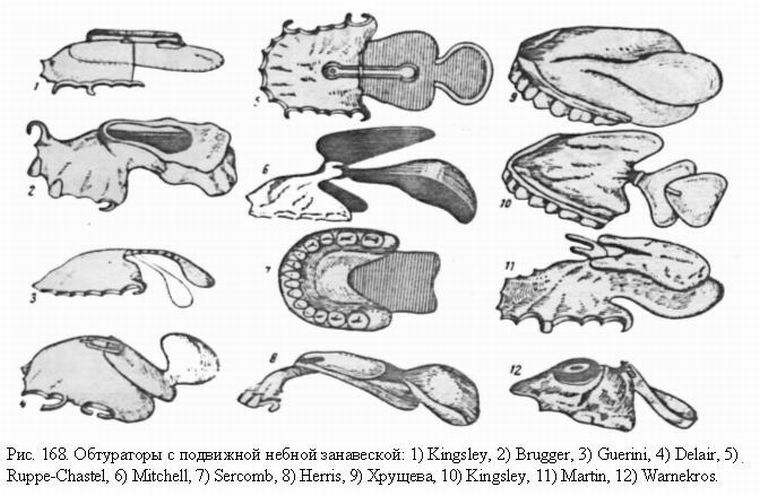
Indications for use
You can use the prosthetic prosthesis starting from birth. Breast children help to alleviate the process of natural nutrition. For this, a floating obturator is used according to Z. Chasovskaya, made of plastic.
Children along with the installation of such a device without fail show logopedic exercises, respiratory gymnastics. With the help of this device, all the natural functions necessary for the proper functioning of the human body are normalized.
There are a number of indications in the maxillofacial surgery when it is necessary to use such products:
- palatine clefts of an innate nature;
- oblique and transverse facial crevices;
- nasal septal defects;
- macrostomy;
- atresia of the nose;
- atresia of the oral cavity;
- palate damage;
- resection on the upper jaw;
- processes that destroy the structure of the palate.
If the defect is limited or there is verbal nasal congestion, it is sufficient to use the palatine plate, and it is not necessary in the obturator.
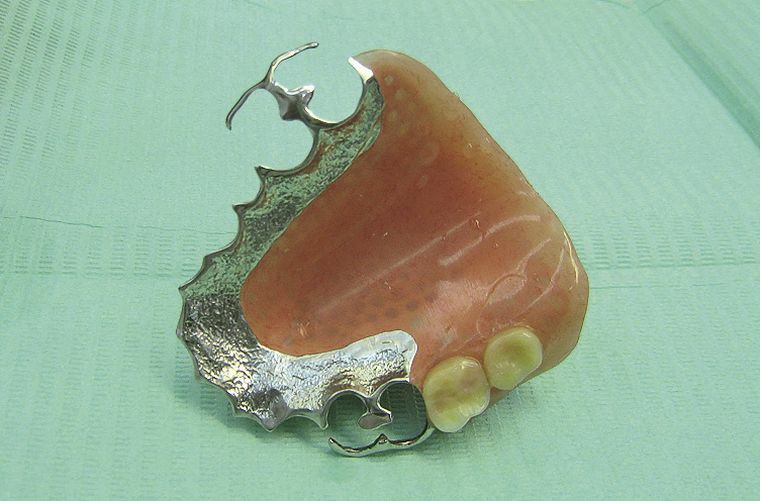
Fixing methods
Obturators differ not only in the material of manufacture, but also in the fixing method. There are three types of fastening:
- fixed ( combined with the base plate);
- mobile ( connected to the base by a spring or a button);
- floating ( cover the edges of the cleft, thereby keeping it).
The palatine plate is attached to the teeth of the upper jaw with the help of clamps, after which the clarity of the sound is restored. It should cover the defect of the palate so that the border between the oral cavity and the nose is obtained. If there are no teeth, then such a plate becomes already a prosthesis, which also contains artificial teeth.
The most famous designs of
The most famous obturators, which are used for defects of the sky to this day.
By Suersen
This device is fixed and connects to the palatine plate. The mold is made with a thermoplastic mass. The model obtained by 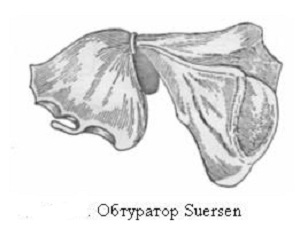 becomes a model for the creation of a plastic plate. Its fixation on chewing teeth will be carried out by clasps. If necessary, the design can be made with artificial teeth.
becomes a model for the creation of a plastic plate. Its fixation on chewing teeth will be carried out by clasps. If necessary, the design can be made with artificial teeth.
An outgrowth is formed on the distal part of the plate, reaching the posterior pharyngeal wall. To obtain the imprint of a defect, this process is smeared with black gutta-percha. At the time of swallowing, the pharynx muscles contract, after which there is a trace on the gutta percha from the defect boundaries. After that the gutta percha is replaced with plastic.
By Shildsky
This unit is presented in two parts. The first is a palatine plate, the second is the obturator itself. Between them they are connected by a movable hinge.
It is made in the form of a spiral spring or a spring plate made of stainless steel. Its width does not exceed 5-8mm, and the thickness is 0.5mm.
In some cases it is recommended to perform a palatine plastic plate with a solid structure, and the device itself is made of soft. But the elastic plastic becomes more solid over time.
Floating obturator Kesa
This device belongs to floating structures, since it does not have a fixing plate. The edges of the obturating part cover the edges of the mucosa, which border directly with the defect.
Due to this, the device is securely attached to the surface of the soft palate. It is more difficult to remove the impression for this purpose, since it is required to obtain a trace from the pathology borders from the mucous membranes of the nose and mouth separately. With the help of the wall, an impression is first made on one side, then on the other.
After that the plate is smeared with petroleum jelly and a general impression is made. As a result, two copies of the opposite sides are glued to one common impression, after which you can start making the device.

Modification of Kesa
The device can be made of aluminum or stainless steel. Its thickness is equal to 1 mm, the length is 12-15 cm, and the width is no more than 15-18 mm. A slightly soft stance is placed on the tip of the plate and inserted into the mouth into the cleft, moving from the back of the defect forward.
After two minutes, the impression is carefully removed from the oral cavity. It is necessary to wait for the cooling of the impression, after which the boundaries of the necessary apparatus are marked on it.
The future device should cover the hard sky from the front. And the rear of the structure should be covered with a soft palate.
Apparatus Ilyina-Markosyan
 This is a composite device in combination with a palatine plate. To produce the latter, soft plastic is used, and the obturator is made from EGMASS-12.The device is fixed by the clamps.
This is a composite device in combination with a palatine plate. To produce the latter, soft plastic is used, and the obturator is made from EGMASS-12.The device is fixed by the clamps.
This unit should cover the back of the hard palate by one third and the soft palate of the oral cavity. It is made by a thin plate and covers the entire cleft palate in the nasal cavity. The connection for both parts is a metal button. For the impression, an elastic mass is used, such as an algalast.
By Pomerantsevo-Urban
The main purpose is to restore the mobility of the soft palate by replacing the defect. The device perfectly restores speech functions.
The device consists of an obturator and a palatine plate with clasps for attachment. The material for manufacturing is solid plastic. Both parts are joined by a steel spring plate.
The product is made with two openings on opposite sides, which are covered with celluloid. The result is two valves, where one works on the exhalation in the oral cavity, the other on inspiration in the nasal cavity.
The product of V. Kurlyandsky
The device of dual purpose, for today, received wide application. The main purpose is to expand the upper jaw.
For this purpose, a plate is used on which a sliding screw is mounted. On the plate in the area of the seam there is an elastic hood. He is responsible for the separation of the mucous membranes of the nose and mouth. Thus, the sliding of the edges of the cleft is stimulated.
Palatine plate
The device is used after the operation to eliminate cracks. Its use during this period has an important auxiliary character. 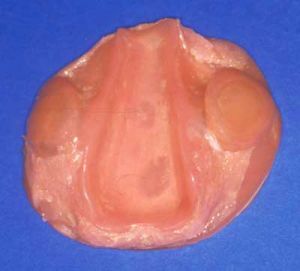
The plate serves as a protective barrier to joints, to avoid possible contamination into the oral cavity. In addition, the plate supports tampons and immobilizes palatine flaps. Thanks to it, the right palatal arch forms.
The protective palatine plate is represented by two separate parts. One of them covers the teeth, and the other performs a protective function for the sky. To the sides of the palate, it should not lie. One part is made in two layers. The elastic plastic was used from the side of the alveolar process.
Solid plastic with a transparent structure is used on the oral side. The second part is single-layer, for the manufacture of which was also a solid plastic( transparent).The palatine plate is characterized by simple installation, reliable attachment and subsequent retention. It completely isolates the wound in the postoperative period, protecting it from possible infection.
Types of obturators differ depending on the shape of the defect, its location and clinical features. To resort to the help of such devices is only when it is impossible to eliminate the defect by plastic surgery or the patient himself refuses to perform surgery.
